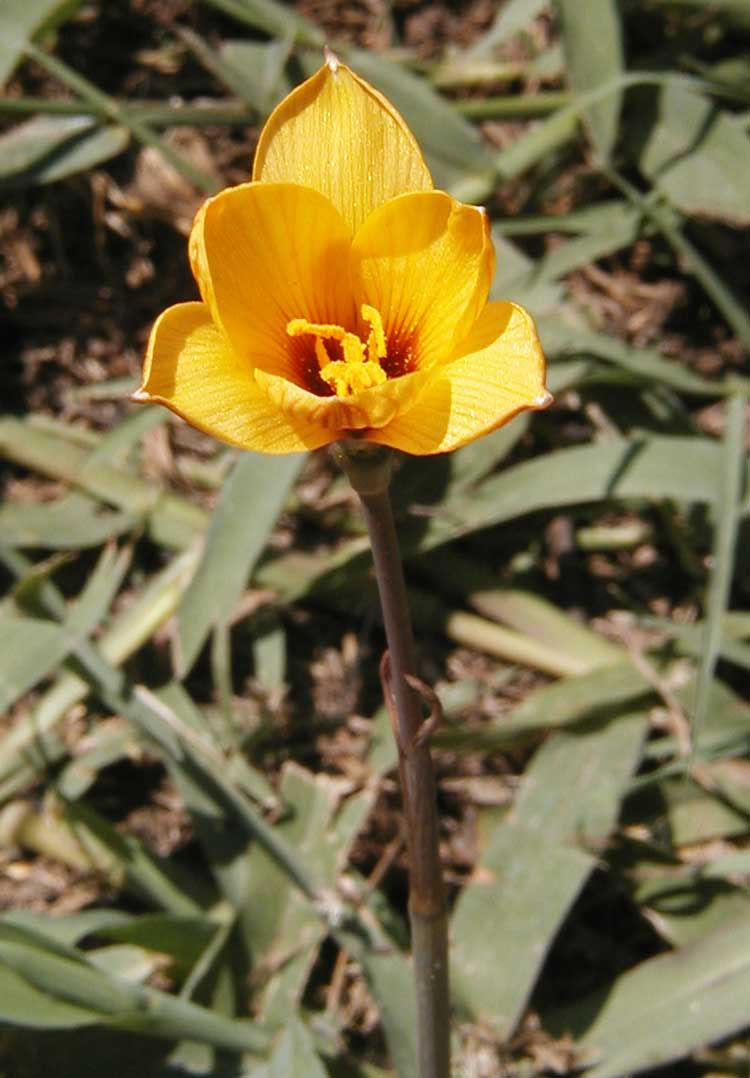
Zephyranthes tubispatha (*)
Classification System: APG IV
Superregnum: Eukaryota
Regnum: Plantae
Cladus: Angiosperms
Cladus: Monocots
Ordo: Asparagales
Familia: Amaryllidaceae
Subfamilia: Amaryllidoideae
Tribus: Hippeastreae
Subtribus: Hippeastrinae
Genus: Zephyranthes
Species: Zephyranthes tubispatha
Name
Zephyranthes tubispatha (L'Hér.) Herb., Appendix: 36. 1821.
Synonyms
Basionym
Amaryllis tubispatha L'Hér., Sert. Angl.: 9. 1789.
Homotypic
Arviela tubispatha (L'Hér.) Salisb., Gen. Pl.: 135. 1866), nom. inval.
Atamosco tubispatha (L'Hér.) M.Gómez, Bol. Secr. Agric. Comerc. Trab., Cuba 22: 106. 1914.
Hippeastrum tubispathum (L'Hér.) Baker, J. Bot. 16: 82. 1878.
Habranthus tubispathus (L'Hér.) Traub, Pl. Life 7: 42. 1951.
Heterotypic
Amaryllis andersonii (Herb. ex Lindl.) Griseb., Symb. Fl. Argent.: 320. 1879.
Amaryllis depauperata Poepp., Fragm. Syn. Pl.: 4. 1833.
Atamasco texana (Herb.) Greene, Pittonia 3: 187. 1897.
Habranthus andersonii Herb. ex Lindl., Edwards's Bot. Reg. 16: t. 1345. 1830.
Habranthus andersonii var. aureus Herb., Amaryllidaceae: 168. 1837.
Habranthus andersonii var. brevilimbus Lindl., Edwards's Bot. Reg. 16: t. 1345. 1830.
Habranthus andersonii var. cupreus Herb., Amaryllidaceae: 16. 1837.
Habranthus andersonii var. obscurus Lindl., Edwards's Bot. Reg. 16: t. 1345. 1830.
Habranthus andersonii var. parvulus Herb., Amaryllidaceae: 168. 1837.
Habranthus andersonii var. texanus (Herb.) Herb., Bot. Mag. 64: t. 3596. 1837.
Habranthus parvulus (Herb.) Pritz., Icon. Bot. Index: 522. 1854.
Habranthus texanus (Herb.) Herb. ex Steud., Nomencl. Bot., ed. 2, 1: 717. 1840.
Habranthus tubispathus f. bicolor (Ravenna) Traub, Pl. Life 31: 76. 1975.
Habranthus tubispathus f. roseus (Ravenna) Traub, Pl. Life 31: 76. 1975.
Habranthus tubispathus subsp. macranthus Ravenna, Pl. Life 26: 102. 1970.
Habranthus tubispathus subsp. variabilis Ravenna, Pl. Life 26: 102. 1970.
Habranthus tubispathus var. bicolor Ravenna, Pl. Life 26: 103. 1970.
Habranthus tubispathus var. roseus Ravenna, Pl. Life 26: 203. 1970.
Habranthus variabilis (Ravenna) Ravenna, Pl. Life 30: 49. 1974.
Hippeastrum andersonii (Herb. ex Lindl.) Baker, J. Bot. 16: 82. 1878.
Hippeastrum texanum (Herb.) Baker, J. Bot. 16: 82. 1878.
Zephyranthes andersonii (Herb. ex Lindl.) Benth. & Hook.f., Gen. Pl. 3: 724. 1883.
Zephyranthes andersonii var. rosea E.Holmb., Anales Mus. Nac. Buenos Aires, III, 2: 79. 1903.
Zephyranthes commersoniana Herb., Amaryllidaceae: 174. 1837.
Zephyranthes texana Herb., Bot. Mag. 63: t. 3482. 1836.
Distribution
Native distribution areas:
Continental: Southern America
Bolivia to S. Brazil and NE. Argentina
References: Brummitt, R.K. 2001. TDWG – World Geographical Scheme for Recording Plant Distributions, 2nd Edition
References
Herbert, W. 1821. An Appendix: [General index to the Botanical magazine, vol. 43-48 containing a treatise on bulbous roots] By William Herbert with plates 36.
Howard, Thad M. 2001: Bulbs for Warm Climates. Austin, TX: University of Texas Press, pp 77-82.
Links
Govaerts, R. et al. 2020. Zephyranthes tubispatha in World Checklist of Selected Plant Families. The Board of Trustees of the Royal Botanic Gardens, Kew. Published on the internet. Accessed: 2020 Aug. 01. Reference page.
International Plant Names Index. 2018. Zephyranthes tubispatha. Published online. Accessed: Aug. 01 2018.
Tropicos.org 2018. Zephyranthes tubispatha. Missouri Botanical Garden. Published on the internet. Accessed: 2018 Aug. 01.
Vernacular names
English: Rio Grande Copperlily
Habranthus tubispathus, the Rio Grande copperlily or Barbados snowdrop,[2] is a species of flowering plant in the family Amaryllidaceae. It is a perennial bulb native to southern South America (Brazil, Argentina, Paraguay and Uruguay). It is widely cultivated as an ornamental and reportedly naturalized in the southeastern United States (Texas, Louisiana, Alabama, Georgia, Florida), much of the West Indies as well as Bermuda, eastern Mexico, India, Easter Island, and central Chile.[3]
Description
Flowers are produced sporadically during late summer and autumn, singly on stems 10 to 20 centimetres (4 to 8 in) tall. Flowers are usually yellow with copper tones on the outside, with tepals about 3 centimetres (1.2 in) long, fused for a short distance at the base to form a tube. As with all Habranthus species, the flowers are not upright on the stem but held at a slight angle. The leaves are not normally present at flowering time, appearing later; they are narrowly linear.[3]
Chemical composition
Contains toxic lycorine.[4]
Cultivation
Habranthus tubispathus tolerates some frost down to 0 °C (32 °F) if planted in a sheltered sunny position, but will not survive being frozen. It seeds freely. A form with pinkish flowers is grown as H. tubispathus var. roseus, but may be a hybrid.[3]
H. tubispathus has gained the Royal Horticultural Society's Award of Garden Merit.[2][5] The synonym H. andersonii is commonly found in horticultural sources.
Growing in Denton, Texas, USA
Growing in Denton, Texas, USA
Seeds
Growing at TWU in Denton, Tx.
References
World Checklist of Selected Plant Families, The Board of Trustees of the Royal Botanic Gardens, Kew, retrieved 2011-09-23, search for "Habranthus tubispathus"
"RHS Plant Selector - Habranthus tubispathus". Retrieved 5 July 2020.
Mathew, Brian (1987), The Smaller Bulbs, London: B.T. Batsford, ISBN 978-0-7134-4922-8, p. 101
"Katoch D and Singh B, Med Aromat Plants" (PDF).
"AGM Plants - Ornamental" (PDF). Royal Horticultural Society. July 2017. p. 44. Retrieved 3 March 2018.
Retrieved from "http://en.wikipedia.org/"
All text is available under the terms of the GNU Free Documentation License

